- This photo feature showcases the influence of Ramayana
in Cambodia esp. in its temple carvings. Beyond
architecture, the Reamker (Cambodia’s version of Ramayana)
thrives in classical dance and shadow puppetry (Sbek Thom).
This article explores the influence of
the Ramayana across Southeast Asia, highlighting how different countries
have adapted it into their literature, art, and performances. Cambodia stands
out for its intricate temple carvings. Beyond architecture, the Reamker (Cambodia’s version of Ramayana) thrives in classical dance and shadow
puppetry (Sbek Thom), ensuring its continued cultural legacy. It
emphasizes how Reamker remains an integral part of Cambodia’s identity, preserving its artistic and spiritual heritage.
The Ramayana, one of the most revered epics of
India, has transcended borders and become deeply embedded in the cultural and
artistic expressions of Southeast Asia. Countries such as Thailand, Indonesia,
Myanmar, Laos, and Cambodia have embraced the epic, incorporating it into their
literature, dance, theater, and temple art. Each region has adapted the story,
merging it with local traditions and beliefs while retaining its core
philosophical and moral essence.
In Thailand, the epic is known as Ramakien, while Indonesia’s Kakawin Ramayana blends elements from both the Indian and Javanese traditions. Similarly, Myanmar’s Yama Zatdaw and Laos’ Phra
Lak Phra Ram have their own adaptations, reflecting unique regional
narratives. However, among these countries, Cambodia stands out for its
exquisite sculptural depictions of the Ramayana, found in its unique
temple complexes.
Ramayana in
Cambodia: Sculpted in Stone
Cambodia’s connection with the Ramayana,
locally known as Reamker, is deeply intertwined with its Khmer heritage.
The most magnificent depictions of the epic can be found in the Angkor temple
complex, particularly in Angkor Wat and the Bayon Temple. The Khmer kings, who
saw themselves as divine rulers, commissioned these intricate bas-reliefs to
adorn their temples, immortalizing the story in stone.
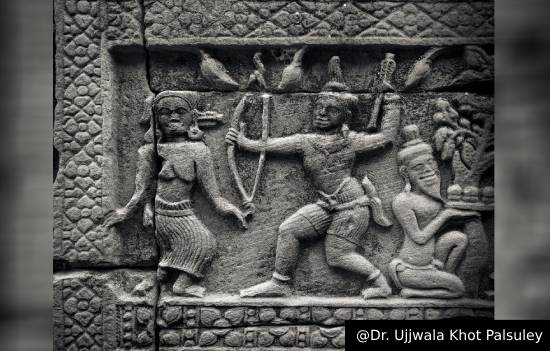 Sri Ram killing Tratika, at Bapoun temple at Siem reap, Cambodia (mid-11th century).
Sri Ram killing Tratika, at Bapoun temple at Siem reap, Cambodia (mid-11th century).
At Angkor Wat, one of the grandest
representations of the Ramayana can be seen on its western enclosure wall. This vast panel illustrates significant episodes such as the battle between Sri Ram and Ravana, the abduction of Sita, Hanuman’s adventures, and various episodes from the war of Lanka.
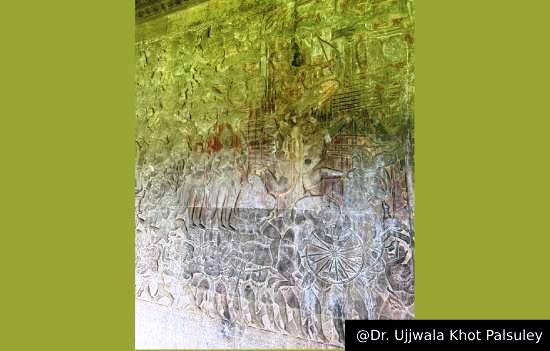 Bas relief
of Ramayana at Angkor Wat Temple, Siem Reap, Cambodia (12th
Century).
Bas relief
of Ramayana at Angkor Wat Temple, Siem Reap, Cambodia (12th
Century).
The carvings exhibit remarkable detail, portraying the
grandeur of Khmer craftsmanship and the profound influence of Indian epics on Cambodian
art.
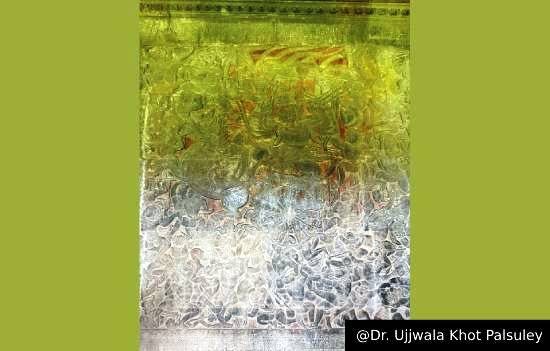 Ravana in the panel of Ramayana at Angkor Wat temple, Siem Reap, Cambodia.
Ravana in the panel of Ramayana at Angkor Wat temple, Siem Reap, Cambodia.
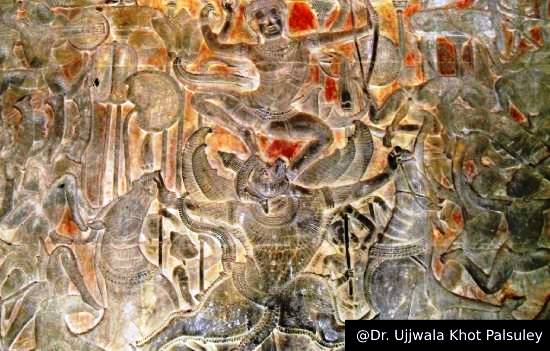 Ram riding Hanuman during the war of Lanka, part of Bas relief of Angkor Wat temple.
Ram riding Hanuman during the war of Lanka, part of Bas relief of Angkor Wat temple.
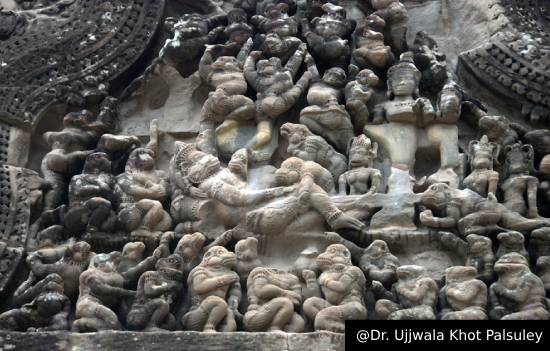 Death of Vali on the pediment at the Angkor Wat temple.
Death of Vali on the pediment at the Angkor Wat temple.
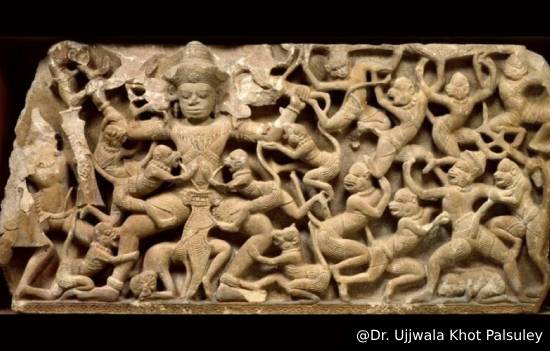 Monkeys
battling with Kumbhakarna, at National Museum of
Cambodia, Siem Reap.
Monkeys
battling with Kumbhakarna, at National Museum of
Cambodia, Siem Reap.
The Bayon Temple, built in the late 12th
century, features another set of Ramayana bas-reliefs, showcasing episodes like the monkey army’s march and Hanuman’s exploits. While weathered over time, these sculptures still convey the dynamism and expressive gestures characteristic of Khmer artistry.
The Banteay Srei Temple, often referred to as the “jewel of Khmer architecture,” is another remarkable site where the Ramayana is extensively depicted. The temple’s intricate pink sandstone carvings include scenes such as Ravana shaking Mount Kailasa, the battle between Ram and Ravana, and episodes featuring Hanuman’s heroics. The high level of detail and refined artistry at Banteay Srei sets it apart as one of the finest representations of the Ramayana in Cambodian temple art.
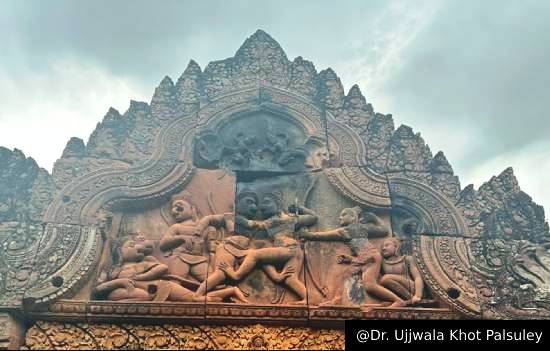 Sugreeva and Bali battle at
Kishkindha scene from Ranayana at Bantey Srei Temple, Cambodia.
Sugreeva and Bali battle at
Kishkindha scene from Ranayana at Bantey Srei Temple, Cambodia.
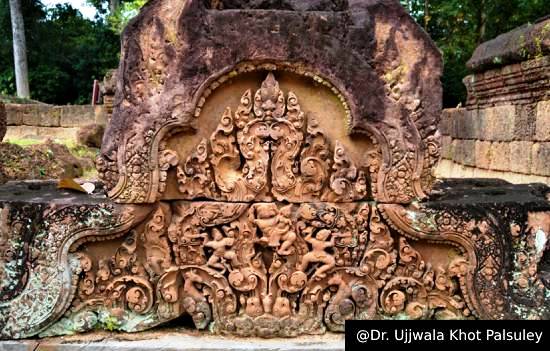 Seeta abduction scene from Ramayana, at Bantaey Srei Temple, Cambodia.
Seeta abduction scene from Ramayana, at Bantaey Srei Temple, Cambodia.
Ramayana in
Cambodian Classical Dance and Shadow Puppetry
Apart from temple carvings, Reamker has also
significantly influenced Cambodian classical dance and shadow puppetry,
ensuring the continued cultural relevance of the epic.
Cambodian classical dance, known for its graceful,
deliberate movements, has long been a medium to narrate the Reamker. Dancers adorned in elaborate costumes depict characters such as Ram, Sita, Hanuman, and Ravana through stylized gestures (mudras), intricate footwork, and expressive facial movements. The dance, performed in royal courts and sacred rituals, serves as a visual retelling of the epic, reinforcing its moral and philosophical teachings.
Shadow puppetry, or Sbek Thom, is another
traditional art form that brings the Reamker to life. Large leather
puppets, intricately carved and mounted on sticks, are manipulated by
performers behind a screen illuminated by firelight. This ancient storytelling
method, recognized by UNESCO as an Intangible Cultural Heritage, is deeply
rooted in Cambodian religious and cultural traditions. The performances are
often accompanied by music and narration, creating a captivating experience
that highlights key episodes from the Ramayana, such as the battle against Ravana and Hanuman’s adventures.
Both classical dance and shadow puppetry play a
crucial role in preserving and transmitting the legacy of the Reamker to
future generations, ensuring its enduring presence in Cambodian cultural
identity.
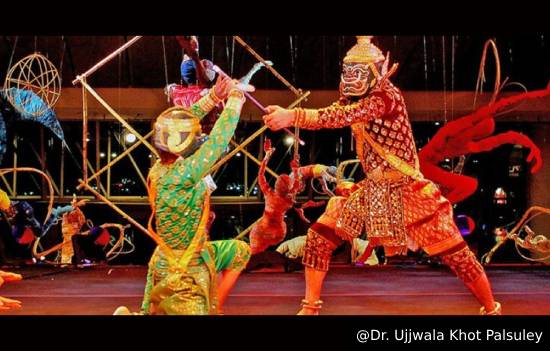 The Khmer Reamker, which follows the protagonist Prince Preah Ream on his quest to rescue his beloved wife Neang Seda from the clutches of the evil giant Reap (Ravana), holds a special place in Cambodian culture.
The Khmer Reamker, which follows the protagonist Prince Preah Ream on his quest to rescue his beloved wife Neang Seda from the clutches of the evil giant Reap (Ravana), holds a special place in Cambodian culture.
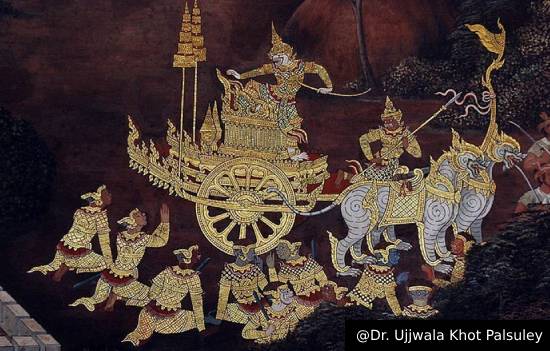 Ramyana Painting in Cambodian local art.
Ramyana Painting in Cambodian local art.
The Ramayana in Cambodia is not merely a borrowed legend but a deeply rooted cultural and artistic expression. The temple sculptures of Angkor Wat, Bayon, and Banteay Srei stand as testaments to the epic’s enduring legacy, illustrating how Indian tradition was seamlessly integrated into the Khmer world. Beyond stone, Reamker continues to thrive through classical dance and shadow puppetry, keeping the epic alive as a dynamic and evolving tradition.
The continued reverence for Reamker in Cambodia reflects its profound role in shaping the nation’s identity, not only as a historical artifact but as a living tradition. Its narratives have been adapted to Cambodian aesthetics and beliefs, blending Hindu and Buddhist elements to create a uniquely Khmer interpretation of the epic. The influence of Reamker extends beyond art and performance, influencing moral values, educational teachings, and social customs in Cambodian society.
Despite modern influences and changing cultural landscapes, the Ramayana remains a cornerstone of Cambodia’s artistic and spiritual heritage. Through temple carvings, dance, and puppetry, the epic continues to inspire, educate, and connect Cambodians to their rich historical past.
The Reamker serves as a reminder of the shared cultural ties between India and Southeast Asia and stands as an enduring symbol of Cambodia’s artistic grandeur and spiritual depth.
To read
all articles by author All pictures
by author
The author is a Conservationist, Architectural
historian, Author, Ph. D. in Dravidian and Khmer temple Architecture, Cambodia
and the Founder of Samrachanā - Heritage Conservation & Research
Initiative, Pune.
Also read
1. Ramayana in SE Asia – A cultural bridge
2. Film on Ramayana – A shared cultural heritage
3. Ramayan
Themed Stamps of Southeast Asia